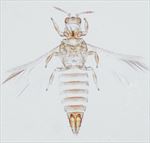Distinguishing features
Female macroptera. Body mainly yellow; brown markings in ocellar triangle, on mesonotum, and medially on tergites II–VII, tergite IX light brown; antecostal ridges dark on tergites III–VIII across full width of segments, on sternites III–VII shaded full width of segments; fore wings weakly shaded, paler toward apex; antennal segment I pale, II dark, III–V pale in basal half, V–VIII dark. Head with vertex bearing closely spaced, transversely anastomosing striae, ocellar region without sculpture lines; bases of ocellar setae pair III separated by the length of these setae, arising within triangle in front of tangent joining anterior margins of posterior ocelli; only one pair of post-ocular setae; ocellar and postocular setae stout with apices blunt. Pronotum with transverse striae weak, irregular and widely separated posteromarginal setae S2 about twice as long as S1, S3 subequal to S1; pronotal setae all slightly flattened and blunt. Metanotum weakly and irregularly reticulate, median setae posterior of margin. Fore wing clavus with 3–4 marginal setae; first vein setae 3–4+1–7+1–4+1–2+1; second vein 1–2 setae; posteromarginal fringe cilia straight. Tergite I without discal setae, III–V median setae short, distance between their bases at least 1.5 times their length; tergal microtrichial fields with few rows of microtrichia and 3 discal setae, the lateral pairs much stouter than the median pairs; VIII with no discal microtrichia medially, posteromarginal comb complete; tergite IX with very weak discal microtrichia on posterior half. Sternites with microtrichial fields weak or absent.
Male macroptera. Similar in colour and sculpture to female, but smaller; abdominal segment IX with pair of dark grooved drepanae with pointed apices curving dorsally; aedeagus without paired array of spines.
Related species
The genus Scirtothrips comprises over 100 described species worldwide, with 21 species known from Australia most of which are endemics to this continent. These species all have the lateral thirds of the abdominal tergites covered in closely spaced rows of fine microtrichia, and in many species the sternites also bear similar microtrichia. The antennae are 8-segmented, except in S. casuarinae and S. solus, both fore wing veins have an irregular and incomplete setal row, and a median spinula is present on both the meso and metafurca. S. moneres has the major setae unusually stout and blunt rather than setiform, but is similar to S. tenor in having the tergal microtrichial fields exceptionally weak and the sternites almost devoid of microtrichia, in contrast to most members of the genus Scirtothrips. Despite this, S. moneres is probably closely related to S. kirrhos and S. quadriseta, both of which also live on Acacia foliage.
Biological data
Presumably feeding and breeding on young phyllodes of Acacia spp [Mimosaceae].
Distribution data
Known only from Western Australia, Northern Territory and Queensland.
Family name
THRIPIDAE - THRIPINAE
Species name
Scirtothrips moneres Hoddle & Mound
Original name and synonyms
Scirtothrips moneres Hoddle & Mound, 2003: 26.
References
Hoddle MS & Mound LA (2003) The genus Scirtothrips in Australia (Insecta, Thysanoptera, Thripidae). Zootaxa 268: 1–40. http://www.mapress.com/zootaxa/2003f/zt00268.pdf




